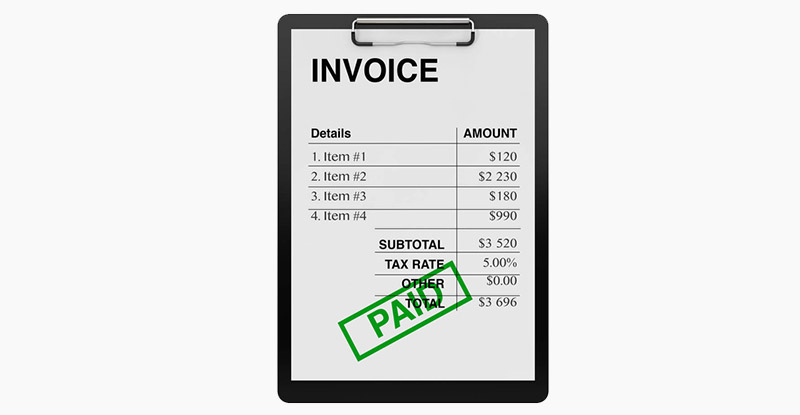Mastering Invoice Payments:
A Comprehensive Handbook
Unlock the Secrets of Streamlined Invoice Payments: Navigating a Hassle-Free Financial Management Experience with ArtsylPay.


As a business owner, you know how important it is to keep your finances in order. Whether you own a small or large company, streamlining your accounting process is crucial to ensuring the success of your business. Being able to manage your invoices properly is one of the key aspects of accounting, as it keeps the cash flow steady.
In this guide, you will discover everything you need to know about invoice payment, from the basics to the crucial steps for streamlining your accounting process.

ArtsylPay is here to make that a reality. Our platform not only simplifies your transactions but also adds a layer of unmatched security to your payments. Join the ranks of satisfied customers who have transformed their businesses with ArtsylPay. Start today and feel the difference!
The invoice payment processing checklist, often referred to as the accounts payable process, involves a series of steps that businesses follow to manage and pay the bills or invoices they receive from vendors or suppliers. Here’s a general overview of this process:
The process starts when a company receives an invoice from a supplier or vendor. Invoices typically include details such as the amount owed, payment terms, and a description of the goods or services provided.
Upon receipt, the invoice is reviewed to ensure accuracy. This includes verifying that the goods or services were received and match the order and that the billing details (such as amount, vendor information, etc.) are correct.
Once verified, the invoice must be approved for payment. In many organizations, this involves a manager or other authorized personnel confirming that the invoice is correct and should be paid.
The invoice details are then entered into the company’s accounting system, updating the accounts payable ledger. This helps in tracking outstanding liabilities and managing cash flow.
RELATED: Simplifying Full Cycle Accounts Payable Invoice Process
Based on the payment terms (like net 30, net 60 days), the payment is scheduled. Some companies may prioritize payments based on vendor terms, cash flow considerations, or early payment discounts.
Payment is made via the chosen method (e.g., bank transfer, check, credit card). The date of payment and method are recorded in the accounting system.
After the payment is made, the accounts payable ledger is updated to reflect the payment, and the invoice is marked as paid. This helps in maintaining accurate financial records.
The paid invoice is then filed or archived, either physically or digitally, for record-keeping and future reference. This is important for audits, financial analysis, and historical records.
Regular reports may be generated from the accounts payable system to provide insights into spending, cash flow, vendor relationships, and financial obligations.
This process ensures that all financial obligations to suppliers and vendors are met in a timely and organized manner. It’s crucial for maintaining good vendor relationships, ensuring legal and contractual compliance, and managing company finances effectively.
Are you ready to elevate your invoice management system? InvoiceAction is the answer. Our innovative solution simplifies your payment process, offering you peace of mind and more time to focus on growing your business. Don’t get left behind. Join the movement towards a smarter, more efficient future with InvoiceAction!
Book a demo now
Many businesses often underestimate the importance of payment processing when it comes to invoicing. Payment processing, in essence, is the process of collecting payments from customers and clients for goods and services provided.
Implementing streamlined payment processes ensures that you get paid promptly and on time, keeping cash flow steady within your business.
This, in turn, will help you to avoid cash flow bottlenecks and ensure your business remains financially stable. Therefore, investing in payment processing is essential for any business looking to thrive.
RELATED: What is an Invoice, and Why Is It Important for Businesses?
Businesses and individuals use various methods for paying invoices. Each method has its own advantages and is suitable for different scenarios. Here is a common invoice payment method example:
Choosing the right payment method depends on factors like transaction size, convenience, record-keeping preferences, processing fees, and the relationship between the payer and payee. Businesses often offer multiple payment options to accommodate different preferences and scenarios.
While online payment platforms are highly convenient, not all customers may want to make payments online.
In such cases, you should consider enabling traditional offline payment methods such as phone payments, bank transfers, and payments by cash or cheque. For small businesses or local transactions, cash payments are sometimes preferred, though they lack the security and traceability of digital methods.
These methods allow customers to choose the payment option that works best for them, which ultimately leads to increased customer satisfaction.
Why settle for less when you can have the best? ArtsylPay offers you an unparalleled invoice payment solution that combines convenience with top-notch security. Let us take the stress out of your payment process. Embrace the change, choose ArtsylPay, and watch your business efficiency soar!
Book a demo now
Invoice payment terms and conditions outline the expectations and requirements for payment between a business and its clients or customers. These invoice payment terms are usually specified on the invoice itself and can include details like the payment due date, acceptable payment methods, late payment penalties, and any discounts for early payment.
Here you will find the invoice payment terms and conditions sample:
These invoice payment terms are crucial for ensuring both parties understand their obligations and help in maintaining a smooth financial relationship.
Even with streamlined invoicing processes, it’s possible to receive late payments. Managing late invoice payments is a critical aspect of maintaining healthy cash flow and business relationships. Here are strategies and practices for effectively handling late invoice payments:
Clear Payment Terms: Ensure that your invoices include clear payment terms (such as net 30 days) and due dates. This sets expectations right from the start.
Invoice Promptly: Send invoices as soon as the goods or services are delivered. Delays in invoicing can lead to delays in payment.
Payment Reminders: Before an invoice is due, send a friendly reminder to the client. Automated reminder systems can be helpful for this.
Follow-Up After Due Date: If payment hasn’t been received by the due date, follow up promptly with a polite but firm email or phone call. It’s important to maintain professionalism while expressing the urgency of payment.
Flexible Payment Options: Offering multiple payment methods can make it easier for clients to pay and might speed up the process.

Contact Us for an in-depth
product tour!
RELATED: A Guide to Final Invoice: Everything You Need to Know
Understand the Reason for Delay: Communicate with the client to understand why the payment is late. Sometimes, it could be due to a simple oversight or an error in the invoice.
Negotiate Payment Plans: If the client is facing financial difficulties, consider negotiating a payment plan. This can help maintain a good relationship with the client while ensuring that the payment is received over time.
Late Payment Fees: Implementing a policy for late payment fees can be a deterrent to late payments. However, it’s important to apply this policy consistently and fairly.
Maintain Records: Keep detailed records of all communications and reminders sent regarding late payments. This documentation can be crucial if the situation escalates.
Legal Action: As a last resort, legal action can be taken against clients who fail to pay. Before proceeding, evaluate if the cost of legal action is worth the amount owed.
Credit Checking New Clients: For new clients, consider performing a credit check to assess their payment reliability before extending credit terms.
Review Credit Policies Regularly: Regularly review and update your credit policies based on experiences with clients and industry practices.
Use of Debt Collection Agencies: If internal efforts fail, using a debt collection agency is an option. They specialize in collecting unpaid debts, though they typically take a percentage of the collected amount as their fee.
Effective late invoice payment management is about balancing firmness in ensuring payments are made while maintaining positive client relationships. It’s important to handle late payments tactfully and professionally, considering each client’s specific circumstances.
Take the leap into a world where invoice payments are effortless and secure. With InvoiceAction, you’re embracing a smarter way of doing business. Our platform ensures accuracy, speed, and reliability in every transaction. Join the docAlpha family today and start enjoying a hassle-free invoicing experience!
Book a demo now
Electronic transfer platforms offer a range of functionalities designed to simplify and optimize the process of invoice payments, enhancing the overall efficiency of accounting and financial management for businesses. Here’s how ArtsylPay and similar platforms contribute to streamlining invoice payments:
In summary, ArtsylPay and similar electronic transfer platforms address many of the challenges associated with traditional invoicing and payment processes. By automating and streamlining these tasks, businesses can focus more on core activities and strategic growth while ensuring their financial operations are handled efficiently and securely.
Transform your invoice payment process with ArtsylPay! This flexible secure payment processor is here to streamline your payment process with ease and efficiency. Say goodbye to manual data entry and hello to swift, secure transactions. Don’t let outdated methods hold your business back. Upgrade to ArtsylPay now and experience the future of invoice payments!
Book a demo now
Payment processing is a crucial aspect of accounting, which is why businesses must implement strategies that can streamline their invoicing process. By utilizing online payment platforms, offering offline payment options, implementing late payment management practices, and utilizing invoice payment systems, you’ll be able to create a smooth invoicing process that benefits both the company and its clients.
Implementing these strategies will make it easier for customers to make payments on time, reducing the time you spend chasing payments and keeping your accounts receivable to a minimum. Take these suggestions into consideration and you’ll be able to streamline your accounts payable process in no time!
An invoice payment definition is paying a bill or invoice from a vendor or supplier for their goods or services. This includes details such as the amount due, payment terms, and the methods of payment.
You can pay invoices using various methods like bank transfers, checks, credit or debit cards, online payment platforms, or cash, depending on what the vendor accepts.
An invoice payables spreadsheet typically includes columns for invoice number, vendor name, invoice date, due date, amount due, payment status, and any notes for reference.
Typical payment terms are net 30, net 60, or net 90 days, indicating the number of days you have to make the payment.
Paying an invoice late can lead to late fees, harm your credit rating, and potentially damage your relationship with the vendor, so it’s crucial to adhere to the specified payment terms.
Negotiating payment terms with the vendor is often possible, especially if you have a good relationship or significant leverage as their customer.
This is a digital platform for processing, sending, and receiving invoice payments online, often featuring automated reminders and reporting.
Online invoice payments are generally safe on reputable and secure platforms. Make sure the service uses encryption and adheres to security standards.

Tracking invoice payments can be done through accounting software, spreadsheets, or manual record-keeping, with many businesses using financial software for accuracy and efficiency.
If there’s a disputed charge, immediately contact the vendor to discuss and resolve the issue, providing evidence for your claim and seeking a solution.
Early payments can sometimes earn discounts, strengthen relationships with suppliers, maintain a good credit rating, and enhance cash flow management.